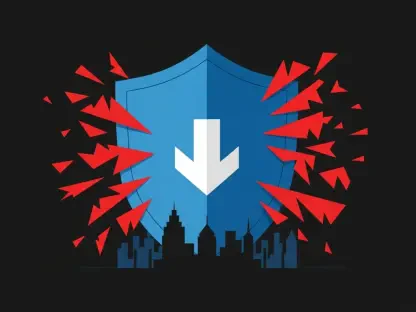In an era where technology permeates every aspect of life, the boundary between digital threats and physical harm has become alarmingly thin, raising critical questions about safety and security in a hyper-connected world. Cyber attacks, once thought to be limited to data theft or network outages, now pose a direct risk to the physical environment, capable of causing property destruction, environmental disasters, and even bodily injury. Imagine a scenario where a hacker infiltrates a factory’s control system, manipulates machinery to overheat, and triggers an explosion that damages equipment and endangers workers. Such incidents are no longer the stuff of science fiction but a growing reality as the integration of digital and operational systems deepens. This exploration delves into the mechanisms behind these cyber-physical threats, the challenges they present to businesses, and the urgent need for comprehensive strategies to mitigate their impact. From insurance gaps to emerging technologies, understanding this evolving danger is essential for safeguarding both virtual and tangible assets.
Unpacking the Cyber-Physical Threat Landscape
The convergence of information technology (IT) and operational technology (OT) has redefined the scope of cyber risks, creating vulnerabilities that extend far beyond the digital realm. IT systems manage data and communications, while OT controls physical processes like machinery in factories or heating in buildings. When these systems are linked, a breach in one can directly impact the other, leading to real-world consequences. For example, a cyber attack on a manufacturing plant’s network could disable safety protocols, causing equipment to malfunction and potentially explode. This interplay means that digital security lapses can translate into tangible harm, making it imperative for businesses to recognize that a firewall alone cannot protect against a burst pipe or a chemical spill triggered by malicious code. The stakes are extraordinarily high, as the potential for damage isn’t just financial but includes risks to human safety and critical infrastructure.
Certain industries face heightened exposure due to their reliance on interconnected systems, amplifying the potential for cyber attacks to cause physical damage. Sectors such as manufacturing, energy, transportation, and hospitality often depend on automated controls for everything from production lines to building management systems. A breach in a power grid’s cybersecurity, for instance, could disrupt safety mechanisms, leading to blackouts, fires, or even environmental catastrophes like oil spills. These scenarios underscore a critical shift: traditional cybersecurity measures, focused on protecting data, fall short when the outcome is a real-world disaster. Businesses in these fields must grapple with the reality that their digital vulnerabilities are inseparable from their physical operations, necessitating a more holistic approach to risk management that accounts for both realms of potential harm and bridges the gap between virtual defenses and tangible outcomes.
Bridging the Insurance Divide for Hybrid Risks
One of the most pressing obstacles in addressing cyber-physical threats is the inadequacy of existing insurance frameworks to cover the full spectrum of potential damages. Traditional property insurance policies are designed for physical losses like fire or theft but often exclude damages resulting from cyber events. Conversely, many cyber insurance plans focus on digital losses such as data breaches and may not extend to physical harm, bodily injury, or environmental impacts caused by a hack. This coverage gap can leave businesses financially exposed after an incident, with the added burden of navigating disputes over which policy—if any—applies to a hybrid event. The uncertainty surrounding these overlaps complicates recovery efforts, as companies may face significant delays or denials in claims processing, highlighting a critical need for clearer policy terms and broader protections tailored to modern risks.
To mitigate these financial vulnerabilities, businesses must take proactive steps to understand and negotiate their insurance coverage with precision and foresight. Reviewing the fine print of both property and cyber policies is essential, as exclusionary language can create unexpected blind spots. Engaging with knowledgeable brokers can help clarify ambiguities and advocate for customized terms that encompass cyber-induced physical damage. As cyber-physical incidents become more common, insurers are slowly adapting, but the onus remains on organizations to push for comprehensive solutions during policy renewals. Without such diligence, the aftermath of an attack could be as devastating financially as it is operationally, leaving companies to bear the cost of repairs, lawsuits, or regulatory penalties alone. This evolving landscape demands a shift in how risk transfer is approached, ensuring that protections keep pace with the dual nature of today’s threats.
Confronting New Dangers from AI and Deepfakes
Emerging technologies like artificial intelligence (AI) are reshaping the cyber threat landscape, introducing novel ways for attacks to spill over into the physical world with alarming consequences. When AI-driven systems, which often control critical operations in industries like energy or transportation, are compromised or fed malicious data, they can execute harmful actions. For instance, a hacked AI managing a dam’s floodgates might release water at the wrong time, causing flooding and property damage downstream. These scenarios illustrate how reliance on automated decision-making amplifies the stakes of a cyber breach, as the technology’s reach extends directly into real-world environments. The sophistication of such attacks challenges existing defenses, as they exploit trust in systems designed to enhance efficiency, turning a tool of progress into a vector for destruction that demands urgent attention.
Beyond operational systems, AI-powered deepfake technology poses a unique and insidious risk by enhancing social engineering tactics that can lead to physical or financial harm. Deepfakes, which use AI to create convincing fake audio or video, can mimic trusted individuals like executives to deceive employees into unauthorized actions, such as transferring funds or disabling security measures. Unlike traditional phishing attempts, these scams often lack obvious red flags, making them harder to detect. A fabricated voicemail mimicking a CEO’s voice could, for example, prompt an employee to override a safety system, resulting in equipment failure or injury. Such incidents blur the lines of standard cyber insurance coverage, as they may not involve a direct network breach. As these threats grow, the need for specialized training and detection tools becomes critical to prevent digital deception from causing tangible damage.
Investigating Causes and Strengthening Defenses
Pinpointing the origin of a cyber-physical incident is a complex yet vital process for both insurance resolution and future prevention. Forensic investigations play a key role in determining whether a loss resulted from a cyber attack or another cause, such as human error or mechanical failure. This attribution is crucial for settling claims, as insurers often rely on clear evidence to decide coverage applicability. However, the intricate nature of interconnected IT and OT systems can obscure the root cause, prolonging disputes and delaying recovery. A breach in a hospital’s network leading to malfunctioning medical equipment, for instance, might require extensive analysis to confirm malicious intent over a software glitch. The challenge lies in navigating this gray area, where technical expertise and legal clarity must align to ensure fair outcomes and inform strategies for mitigating similar risks in the future.
Prevention remains the cornerstone of managing cyber-physical threats, requiring businesses to adopt robust measures that address both digital and physical vulnerabilities. Employee training to recognize suspicious requests, especially those involving financial transactions or system overrides, serves as a first line of defense against social engineering attacks like deepfakes. Additionally, implementing advanced security tools—such as firewalls, IT/OT segregation, and endpoint detection systems—can limit the spread of a breach before it impacts physical operations. Regular audits and stress testing of interconnected systems further help identify weak points. These steps, while resource-intensive, are essential to reduce the likelihood of a cyber incident escalating into real-world harm, emphasizing that proactive investment in security far outweighs the cost of reacting to a disaster after it unfolds.
Charting a Path Through Rising Complexities
As cyber attacks increasingly breach the barrier between digital and physical realms, businesses face a landscape of unprecedented challenges that demand innovative and multifaceted responses. Reflecting on past incidents, it becomes clear that relying solely on traditional cybersecurity or insurance is insufficient to address the hybrid nature of these threats. Companies must integrate stronger defenses, from advanced network monitoring to employee awareness programs, to prevent breaches from cascading into tangible harm. Negotiating comprehensive insurance policies that account for both cyber and physical damages also proves critical in mitigating financial fallout. Looking ahead, the focus should shift toward adopting cutting-edge technologies, like deepfake detection tools, and fostering industry collaboration to standardize risk management practices. By proactively addressing these evolving dangers, organizations can better safeguard their operations and ensure resilience against the next wave of cyber-physical risks.









